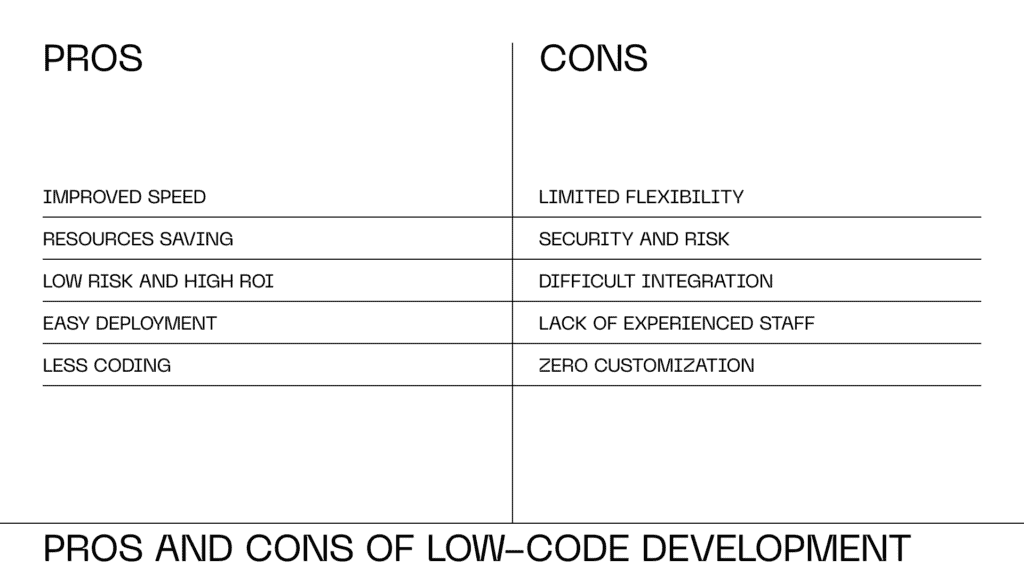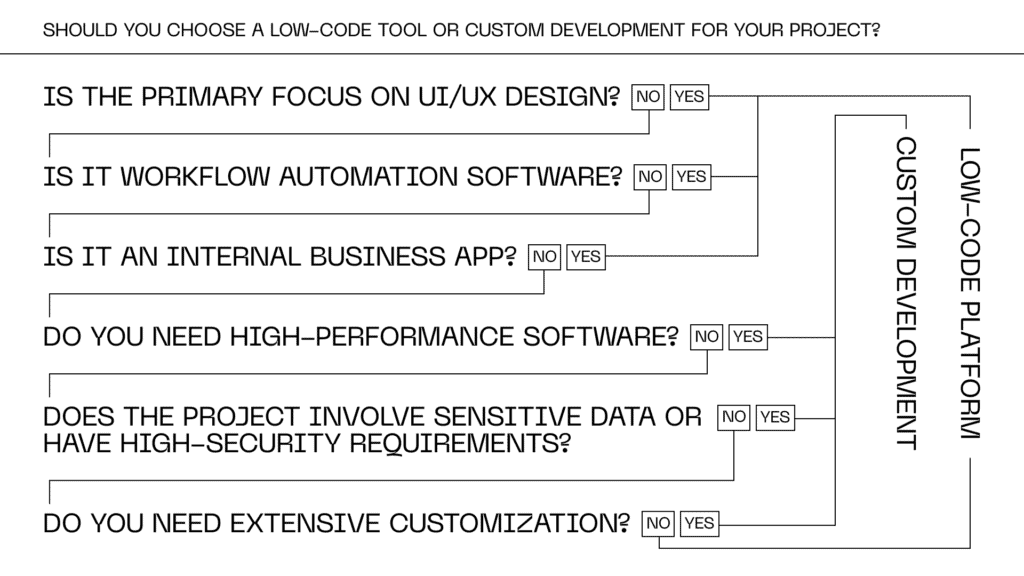According to Gartner, the low-code application technologies market is projected to generate nearly $24 billion in revenue by 2024. With the rising cost of tech talent and the growth of remote workforces, low-code technology adoption is on the rise. Every employee can now automate routine processes without the need for an IT specialist.
In fact, it’s already happening. More than half of custom applications are now being built outside the IT department, with 30% created by non-technical employees. Considering these trends, should you drain your IT operations budget and invest in low-code tools instead?
Before making a decision, let’s explore what has made low-code platforms so popular and examine their benefits.
Benefits of low-code development
Enhanced business agility
Studies have shown that low-code techniques can save up to 50-90% of the time compared to custom software development, depending on the coding language used. By utilizing pre-built components, templates, and visual interfaces, developers can quickly create and customize applications without writing extensive code. This enables fast prototyping and easy adaptation to market changes.
Improved customer experience
With less manual work required, developers can focus on creating seamless and attractive interfaces. Personalization features can be implemented to provide customers with a relevant and consistent experience across all touchpoints.
More efficient use of resources
Low-code development platforms provide an environment where IT and business departments can collaborate closely, breaking down silos and leveraging the expertise of developers and stakeholders. This maximizes knowledge and skills, leading to efficient resource utilization.
Increased access to talent
Visual development tools offered by low-code platforms make it easy for even inexperienced developers to contribute to high-performing teams. This lowers the entry threshold for employees and enables businesses to fill positions more quickly.

Sounds too good to be true? Well, indeed, low-code platforms have limitations that may prevent them from fully meeting your expectations. Let’s take a closer look at them.
Limitations of low-code platforms
Limited customization and flexibility
While low-code platforms offer pre-built components and templates, they may not support complex or unique requirements. Unlike with custom development, troubleshooting, debugging, or implementing unique functionality can be challenging due to restricted access to the underlying code.
Scalability challenges
Low-code software is primarily designed for small to medium-sized applications, and it may struggle to handle large volumes of data, complex business logic, or high user concurrency. As the application complexity and scale increase, low-code platforms may not provide the necessary performance and scalability.
Vendor lock-in
Building an application with a low-code tool ties you to that specific platform and its ecosystem. Switching to a different platform or migrating the application to a different technology stack can be difficult, limiting future growth or technology changes.
Security concerns
Less experienced developers using low-code platforms may overlook aspects like user input validation, data protection, and secure coding practices, potentially exposing applications to security risks. The custom software development process, on the other hand, involves more in-depth quality assurance, minimizing all kinds of risks.
Learning curve for advanced functionality
While low-code platforms simplify application development for non-technical users, there may still be a learning curve when using advanced features or implementing complex logic. Additional training and experience may be required to understand the platform’s design patterns, limitations, and APIs, which can prolong delivery times.
Low-code or custom solution?
Not sure what’s better for your business? Request a consultation with our team.
Contact usWhat can you really do with low-code platforms?
Despite the limitations, low-code development offers numerous benefits and has been successfully utilized in various software solutions alongside custom development. Let’s explore some examples of how businesses have leveraged low-code tools to enhance efficiency and reduce turnover costs.
UI/UX design
Digital mockups typically lack interactivity which makes it difficult for the user to evaluate the intended usability and product’s behavior. Low-code platforms empower UI/UX designers to create more accurate and engaging user experiences by enabling them to focus on design rather than technical complexities.
Thus, Medtronic, a medical device manufacturer, used a low-code solution to enhance employee user experience and streamline front-end processes, resulting in significant time savings.
Workflow automation software
Low-code platforms enable visual modeling, allowing business stakeholders to participate in application development actively. This fosters better alignment between business goals and IT execution, particularly in process-driven app development.
Leaf Home, a logistics management company, successfully transitioned from manual Excel spreadsheets to a low-code-based workflow automation solution, improving staff efficiency and reducing labor costs.
Internal business apps
Low-code platforms offer a cost-effective alternative for developing internal business applications. This is particularly beneficial for smaller companies with limited budgets, as they can create custom apps tailored to their unique needs and requirements.
For instance, Validata, an employment screening application, was initially built using a low-code platform, enabling interdepartmental collaboration and quick validation of the startup idea.

Where do low-code platforms fall short?
While low-code tools are popular and widely utilized, there are certain areas where they cannot beat the advantages of custom software development. This is primarily because custom development provides the freedom to create diverse products and integrate cutting-edge technologies and current trends.
High-performance and complex software
Real-time systems, data-intensive applications, and solutions utilizing AI/ML or blockchain technologies typically require low-level programming languages and fine-grained control over system resources, which go beyond the capabilities of low-code tools.
Additionally, software solutions like ERP platforms, supply chain management systems, and IoT solutions often require deep customization and seamless integration with external systems, which may not be fully achievable with low-code tools.
Security-sensitive software solutions
Applications dealing with financial transactions and sensitive data require adherence to stringent security standards and industry regulations. While low-code solutions provide basic security features, they often lack the advanced security measures needed for such applications.
Custom software development offers the flexibility to create secure architectures, implement robust security protocols, and ensure compliance with regulatory requirements. It also allows for minimizing reliance on third-party software, enhancing overall security and control.
Customization and differentiated capabilities
Low-code platforms provide a range of pre-built components and templates for application development. While this simplifies the development process, it can limit customization options.
Applications built on low-code platforms may have a similar look and behavior, lacking differentiated capabilities. To achieve innovation and unique functionalities, custom development is necessary, leveraging in-depth programming knowledge and specialized libraries that low-code platforms do not support.
Summary: harnessing the best of both worlds
Despite the rising adoption of low-code platforms, custom development remains crucial due to its ability to create tailored products and integrate cutting-edge technologies.
To strike a balance between custom development and low-code platforms, businesses can harness the benefits of both approaches. Developers can leverage low-code platforms as complementary tools within the custom development process, expediting prototyping, simplifying iterative processes, and empowering non-technical team members to contribute effectively.
By adopting a hybrid approach, developers can capitalize on the speed and simplicity of low-code tools while leveraging the control and flexibility of custom development to deliver innovative, secure, and performance-driven software solutions.
